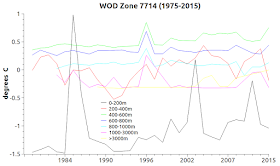 |
| Fig. 1 Layers 7 - 10 |
There are 18 horizontal layers beginning at "the top of the world" (90 deg. N), then proceeding down to the bottom (90 deg. S).
I decided that because this layering approximately parallels the natural atmospheric temperature gradients (warmer at the Equator, then generally getting cooler in the layers nearer to the polar regions).
 |
| Fig. 2 Layer 8 |
I have numbered the layers 0-17, since the WOD zone numbering system uses that style (e.g. Zone 1800-1817).
Anyway, the point of this exercise is to move north and south toward the poles, graphing the big water (all the water, in seven layers, from the surface all the way to the bottom, not just the surface).
 |
| Fig. 3 Layer 9 |
The graphs at Fig. 2 and Fig. 3 are generated from the WOD data in the zones in layer 8 (1000, 1001, 1004, 1005, 1006, 1007, 1008, 1009, 1010, 1011, 1012, 1013, 1014, 1015, 1016, 1017, 7000, 7001, 7002, 7003, 7004, 7005, 7006, 7007, 7008, 7009, 7010, 7011, 7012, 7013, 7014, 7015, 7016, 7017), and layer 9 (3000, 3001, 3003, 3004, 3005, 3006, 3007, 3008, 3009, 3010, 3011, 3012, 3013, 3014, 3015, 3016, 3017, 5000, 5001, 5002, 5003, 5004, 5005, 5007, 5008, 5009, 5010, 5011, 5012, 5013, 5014, 5015, 5016, 5017).
Note that I do not know what this is going to reveal to us, because I do not have all the WOD data downloaded for all WOD zones.
It could get "interesting."
I will download the necessary zones that I don;t yet have (I guess I have about 20% of the WOD zones downloaded and placed into SQL tables).
So, it is also a reason for me to finish that effort.
 |
| Fig. 3 Layer 7 |
What I expect to see are generally changing surface ocean temperatures as we move toward the poles, but I suspect that the lower depths will not all meet that expectation (but it could go that way too).
Who knows, we may discover some warm currents, unexpected mixing of layers, and the like.
I don't know, which is why this is being done (research).
In closing for today, let me explain how the numbers are processed into a graph.
First, the zone data I use (CTD and PFL, two of several categories) is downloaded.
 |
| Fig. 4 Layer 10 |
That data is then processed by "a mean averaging object" (software) which combines the same years and relevant depths into an average (hundreds of measurements within a depth layer level, e.g. depth layer L1, which is 0-200m).
All of those hundreds or thousands of values, after the averaging and sorting, eventually become one of the seven lines on the graph.
This gives us an idea of what has been happening to 'big water' (all of the water) over the years at various depths.
The exclusive use of surface measurements does not do that.
Anyway, the next layers will be 6 and 11 (each one closer to its respective polar region), because I added 7 and 10 to this post (Fig. 3, Fig. 4).
We will visit all the depths recorded by the scientists of the world, then placed into the WOD.
I updated the two graphs (Fig. 2, Fig. 3) after discovering several decimal placement errors (in the WOD data @ the >3000m level).
The next post in this series is here.





















